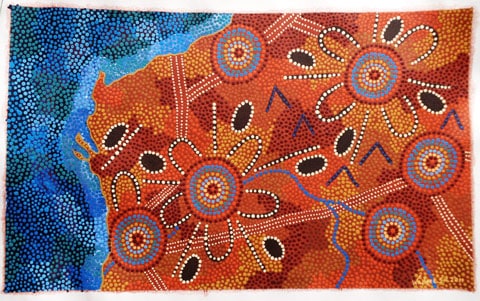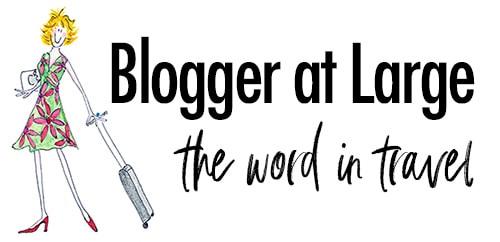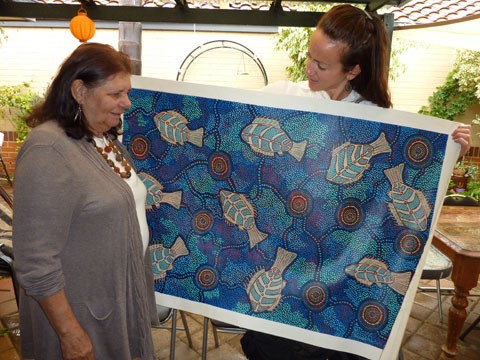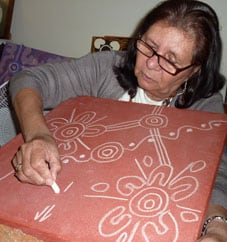Sheila Humphries is a remarkable woman. She’s an acclaimed Aboriginal artist, an elder and a woman whose story begins when she was forcibly removed from her family as part of Australia’s shameful lost generation.
Today I am in her kitchen learning how to paint Aboriginal dot art while she tells her story.
The 70+ year-old mother of eight, grandmother of 30 and great-grandmother of 16, is even in the Guiness Book of Records for her contribution to a 10,000 square metre painting from coloured sand that was photographed from space.
We sit at her table and Rebecca, our tour guide, who has been fortunate enough to get to know Sheila and include a visit to her house as part of her Urban Indigenous Tours, puts the kettle on to make tea.
As Sheila paints, explaining the Aboriginal symbols and what they each mean, I scribble notes and the other journos in the room sniffle into their hankies. Not that I’m a hard hearted old bag, I was just too busy taking notes to let the gravity of her story really sink in.
At the age of four her parents took she and her sister to St Joseph’s Orphanage for Aboriginal girls in New Norcia, north of Perth, in the hopes that they would have a better life than the one their poor parents could provide.
Sheila was one of ten children, nine girls and their step-brother, living in a one-bedroom house. But her treatment in this orphanage was what had us crying, because now we are sitting in silence, while she paints and talks.
She was told she would never amount to anything, that Aborigines just “sit under trees getting drunk”. She made a vow then never to drink and she never has. Each day the girls did chores, washing clothes, ironing (one day she ironed 205 shirts), and cleaning.
At the age of eight her parents decided to move to Perth to get their children a better education, and came back to collect her and her 10-year old sister from the orphanage. But instead of a reunion and well-wishes, the girls were branded absconders and a police alert was put out to arrest them.
Within three months they were found and forcibly removed their parents.
When Sheila describes that day she remembers her mum had a hammer in her hand, there was screaming and they were literally pulled from their mother’s arms and sent back to the orphanage where they went to work as little maids.
Two years later, her mother passed away and she remembers vividly, the reverend mother coming to her and saying, “your mother has died. Get back to work.”
Their father came to visit, but on a strict time allowance. She remembers no comfort from that devastating news and he was asked to leave because she had to get back to prayers.
Let’s just say white people were not Sheila’s favourite race. She lived there until she was 18 and some girls were in their mid-20s, still playing games in the dirt, making dolls and gathering flotsam from the rubbish to make a miniature village, she recalls.
Never maturing into young women, they were never taught personal hygiene, they lived in the same clothes for a week and bathed in the washing machine water.
A Spanish nun told them they were vain if they were caught brushing their hair or looking at their reflection in a window. Fortunately a young Australian nun came and taught the girls about cleanliness.
By the time she got out of there, her father had also passed away. She didn’t know her people and had no extended family. “We had our happy times, but I’m sad to say, they were outweighed by the sad times,” she says with far away eyes in a gentle face that smiles easily.
Sheila’s saviour came in the form of her husband, a lovely Aboriginal man who taught her how to love and be loved.
Through his encouragement she went to college and studied for two years. Thinking it was going to be a program to help Aboriginal adults to read and write, it turned out to be a college course that she eventually graduated from, setting herself up with an education.
Her marriage produced eight children and they set their lives on a course to change their world and “help just one child at a time”.
Her husband has now passed away but with 30 grand kids and 18 great grand kids her home is a happy one.
Paintings hang everywhere and she teaches school groups and tourists like me how to paint those amazing dot art paintings. Her large canvasses sell for up to $3000 directly from her, and I asked her to paint me one (much smaller) and it arrived in the post a few months later.
I love it because it’s Sheila’s interpretation of my journey to see her in Western Australia, and her story is one of amazing triumph through a journey of intense pain.

More of my posts in Australia
Perth is a great city and the anchor for a wonderful Margaret River trip. We did this road trip in 5 days.
Just off the coast of Perth is Rottnest Island, which makes a great little day trip to see the adorable quokkers!
North of Perth is the beautiful Kimberley with its red desert sand and camels on the beach at sunset.
My most recent trip to Australia was to Melbourne where I did some shopping, went to an AFL game and toured the spooky Old Melbourne Gaol.




Indiana
Monday 17th of September 2018
THAT'S MY GRANDMOTHER! I AM ONE OF EIGHTEEN GREAT GRANDCHILDREN OF HERS!!
Megan
Tuesday 18th of September 2018
Oh how amazing! This has given me goose bumps. How is she? I have her piece of art in my home and just love it! x